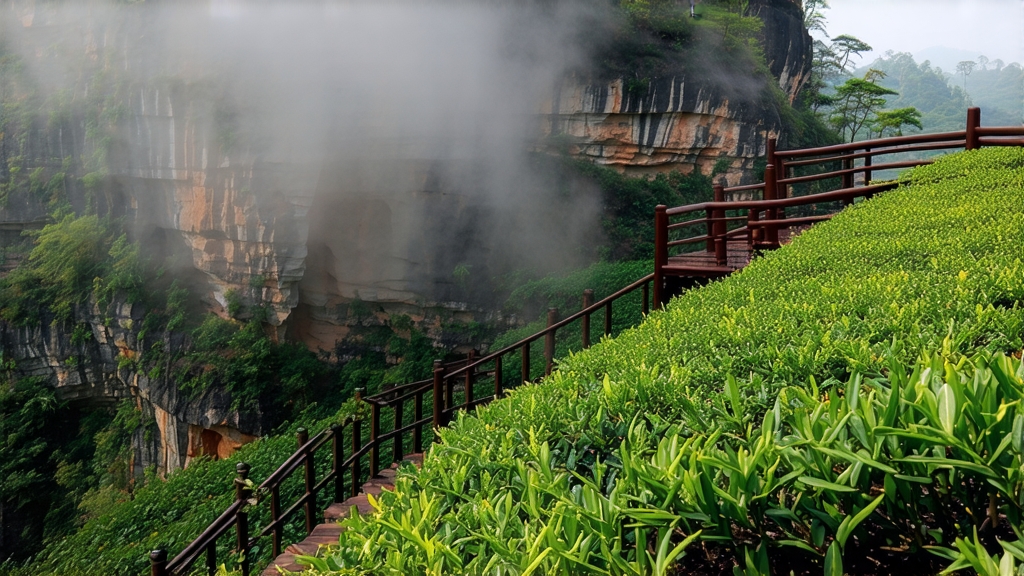
If any Chinese tea can claim both imperial legend and modern rock-star status, it is Da Hong Pao—Big Red Robe—born on the vertiginous cliffs of northern Fujian’s Wuyi Mountains. If you have sipped an oolong that tasted of roasted stone fruit, cocoa and mountain mist, you have already met this king of yan cha, the “rock teas.” What follows is a complete journey through its myth, its many faces, the meticulous craft that tames volcanic soil into liquid velvet, and the quiet ritual that coaxes its soul into your cup.
-
Myth and documented history
Song-dynasty tea monks first fired oolong on Wuyi’s phoenix ridges, but Da Hong Pao’s origin story is fixed in the Ming. According to one chronicle, a Ming emperor’s mother lay gravely ill; a passing monk offered a brew of dark, orchid-scented leaves plucked from six bushes clinging to Tianxin Rock. The empress recovered, the emperor sent crimson silk robes to drape the bushes in gratitude, and the name “Big Red Robe” was sealed. The original mother trees, now protected by UNESCO and last harvested in 2006, still stand above the Nine-Dragon Gorge, guarded by cameras and myth. Cuttings taken in the 1980s created the garden descendants that supply today’s market, so the bloodline lives on even though the imperial bushes themselves are retired. -
Terroir: why “rock rhyme” cannot be faked
Wuyi is a 650-million-year-old rift valley where granite and tuff have weathered into a mineral-rich, paper-thin topsoil. Bushes root directly into fissures, sipping groundwater filtered through limestone and quartz. The gorge traps morning fog, slowing photosynthesis and concentrating amino acids. The result is yan yun—literally “rock rhyme”—a tactile finish that Chinese tasters describe as “a tremor in the throat that returns like distant temple bells.” No other oolong, not even Taiwan’s high-mountain cousins, can replicate this limestone echo because the geology is unique. -
Garden taxonomy: mother trees, qi dan, bei dou and commercial blends
Purists speak of three generations. (1) Pure Qi Dan: direct clonal offspring of the six mother trees, DNA-verified, grown inside the 60 km² core scenic reserve. Yield is tiny, price astronomical. (2) Bei Dou #1 and #2: early 1980s grafts planted just outside the reserve; they capture 70 % of the yan yun at 5 % of the price. (3) Blended Da Hong Pao: artful marriages of 3–5 Wuyi cultivars—often Rou Gui for spice, Shui Xian for body, and Tieluohan for sweetness—designed to give drinkers a balanced “rock tea experience” at everyday cost. Knowing which tier you hold prevents both sticker shock and disappointment. -
Craft: the sixteen steps that turn green leaf into red-robed alchemy
Plucking happens in late April when three half-mature leaves and a tight bud form the classic “dragonfly head.” Withering is done first outdoors on bamboo racks for 30 minutes of soft sunrise, then indoors on water-heated troughs; the goal is 20 % moisture loss and the first whisper of grass-to-fruit conversion. Leaf bruising follows: the leaves are tossed in a bamboo drum rotating at 18 rpm, rupturing cells just enough to invite oxidation enzymes without shredding the leaf. Oxidation itself is arrested at 30–40 %—less than Taiwanese oolongs—preserving green florality while developing cocoa notes. The critical Wuyi twist is the charcoal roast: low-temperature firing over local lychee-wood embers at 80 °C for 8–12 hours, repeated up to three times with a month’s resting between each bake. The slow roast drives out remaining moisture, fixes the aromatic oils, and layers the cup with ember-kissed minerality. Final sorting is done by eye and hand; only intact, aromatically uniform leaves are deemed worthy of the name. -
Tasting lexicon: decoding yan yun
Professional cuppers judge Da Hong Pao on five verticals. Aroma: orchid, roasted apricot, and the scent of hot river stones. Liquor color: translucent mahogany with a golden meniscus. Body: thick enough to coat